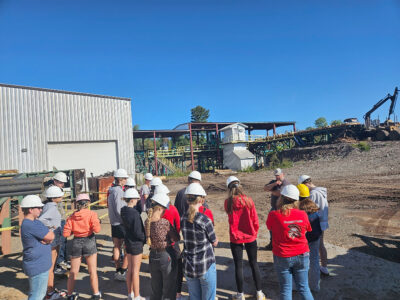Cooks Run habitat earns praise
Study shows Iron County-owned property has no lingering effects of use as fish hatchery
- CAROLE GABBARD OF White Water Associates checks water temperatures as part of a study done in 2024 to assess the overall health of Cooks Run in Iron County. The 122-acre former fish hatchery was built in Stambaugh Township as a Public Works Administration project during the Great Depression — the log caretaker’s cabin is listed on the National Register of Historic Places — but has been owned by Iron County since 1961. (Courtesy photo)
- THE COOKS RUN property has habitat favored by some species of concern in Michigan, such as this yellow-throated warbler. (Gabbard photo)
- THE COOKS RUN property in Iron County has some prime habitat for songbirds such as this yellow warbler. (Gabbard photo)
- THE FORMER COOKS RUN fish hatchery in Iron County’s Stambaugh Township was added to the National Register of Historic Places in 1983. (National Register of Historic Places files)

CAROLE GABBARD OF White Water Associates checks water temperatures as part of a study done in 2024 to assess the overall health of Cooks Run in Iron County. The 122-acre former fish hatchery was built in Stambaugh Township as a Public Works Administration project during the Great Depression — the log caretaker’s cabin is listed on the National Register of Historic Places — but has been owned by Iron County since 1961. (Courtesy photo)
STAMBAUGH TOWNSHIP — A study done at Cooks Run found the site in Iron County remains a high-quality and productive coldwater stream, with no long-term effects from the decades of use as a fish hatchery.
Bette Premo of the Iron County Watershed Coalition detailed findings of the study in a recent report to the Iron County Board.
The hatchery was built in Stambaugh Township as a Public Works Administration project during the Great Depression. The 122-acre site includes fish rearing ponds, a small coffer dam, several outbuildings and a log caretaker cabin that is listed on the National Register of Historic Places. Iron County took ownership of the property in 1961.
The property 15 miles west of Iron River last operated as a fish hatchery in 2013, when Dino Giannola of Watersmeet Trout Hatchery used it for one season after it had sat idle for several years.
The future of the county-owned property has been the topic of discussion at county board meetings for many years. Due to a reverter clause in the deed, the property cannot be transferred to private ownership or it reverts back to the state of Michigan. However, the county can have logging done on the land.

THE COOKS RUN property has habitat favored by some species of concern in Michigan, such as this yellow-throated warbler. (Gabbard photo)
The Iron County Watershed Coalition supported and participated in the assessment, done in 2024, that was intended to provide scientific information toward deciding what human activities could occur in the future along Cooks Run.
The study was done by biologists from White Water Associates, Inc. of Amasa and funded by the Wilderness Shores Mitigation and Enhancement Fund, which We Energies established to mitigate, improve and enhance fish and wildlife habitat around the Wilderness Shores Settlement Agreement hydroelectric projects that includes portions of Iron, Dickinson and Menominee counties.
The study focused on the water habitat and its organisms. Every two weeks, the stream’s incoming and outgoing sources were monitored for water temperature, dissolved oxygen and nutrient content.
Biologist Carole Gabbard said the results surprised them.
“We were expecting that where the pool is relatively wide and slow flow that the temperature was going to be warm, extremely warm,” Gabbard said. “But that wasn’t the case.”

THE COOKS RUN property in Iron County has some prime habitat for songbirds such as this yellow warbler. (Gabbard photo)
Instead, Cooks Run remains a coldwater stream ideal for brook trout.
The study also found the chemical composition of the sediment presented no risk to areas downstream and the concrete abutments that remain are neutral to the Cooks Run channel from an ecological standpoint — in fact, removing them would cause more harm than good by stirring up the sediment, the biologists said.
Although it was not part of the study, the biologists also noted high-quality forested wetlands and riparian habitat at the site, with trees of diverse species and ages.
The habitat is ideal for a variety of bird species, they added, and is likely to harbor state-listed species of concern such as northern goshawk, merlin, evening grosbeak, cerulean warbler and golden-winged warbler. It is potential habitat for the northern long-eared bat, little brown bat and the wood turtle as well, all considered threatened in Michigan.
The study concludes that no restoration efforts will be needed and the wetlands and riparian forest should be protected from forest harvest and other invasive activities.

THE FORMER COOKS RUN fish hatchery in Iron County’s Stambaugh Township was added to the National Register of Historic Places in 1983. (National Register of Historic Places files)
Biologists Jesse Gabbard and Dean Premo said they would like to see Cooks Run stay unlogged and perhaps become a recreational and educational area. Gabbard noted the concrete abutments would be perfect for a walking bridge or fishing platform and roads now too overgrown for a vehicle to drive could become walking trails.
Dean Premo fears county officials have not considered if the monetary gains from logging Cooks Run are worth the potential harm.
“Some of that risk is the loss of the place as an educational or recreational facility,” Premo said. “There are certainly other animals that live in that forest and there is some risk of a forest management operation on the stream.”
At this time, the county board has not approved the harvest of timber on the Cooks Run site; however, trees on the property have been marked for a select cut.
The Iron County Watershed Coalition will present the findings of the Cooks Run study at its annual meeting at 6 p.m. Wednesday, May 21, at the West Iron County Library in Iron River.









